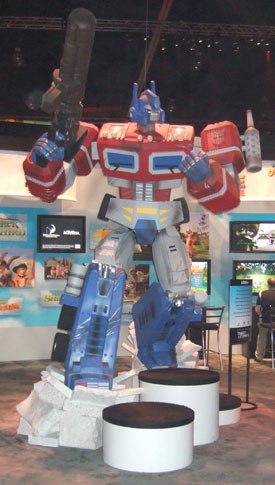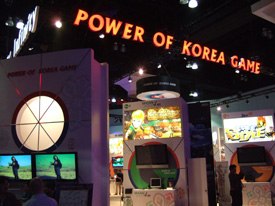For the third year in a row, Rick DeMott travels across town to E3 to uncover the secrets to the future of gaming.
Now having attended three E3s, I can manage the terrain much better. As the mecca for the gaming industry, the event is a must attend for all involved in the $10 billion entertainment sector. However, this year, the crowds seemed lighter and thats not a bad thing. The volume of the booths was dialed down from 11, which was a good thing. And the amount of booth babes (which was advertised as being more discreet) remained the same, which is good or bad depending on ones own perspective.
Wii Non-Gamers Are the Future
The word on everyones lips at this E3 was Wii. Thats pronounced we. The renamed Revolution Nintendos next-generation console was the must see item of the convention. Attendees anxiously waited each morning to rush in and be the first in line to get their hands on the revolutionary consoles unique controller. Some waited up to six hours to get into the booth.
For those who dont already know, Wii features a motion-sensor controller that can mirror the movement of a tennis racket in a sports game or a samurai sword in a fighting game. The controller also features a second controller attachment, which makes the combined controller look like a numchuck. This second controller features a joystick for more complex gameplay. The controller also features a speaker, creating a depth of sound experience in Wii games. For instance, Nintendo demoed the new Zelda game where players simulate the action of a bow by pulling back the Wii wand like the string. In the controller, gamers hear the tension of the string as the pull back and once they push the button to fire hear the whish of arrow.
Im not a hardcore gamer at all, and can safely say the Wii system is very intuitive for people who do not play regularly. Its people like me that Nintendo and the rest of the gaming industry is really eyeing. The idea behind Wii is to attracted people who use to play games but have stopped or people who have never played. I think the easy to use controller will help in attaining this goal.
Over the last four years, retail sales in the gaming industry have been flat. If the industry wants to grow, it needs to attract new consumers. In many of the conference sessions, various insiders talked about this time in the gaming industry as a critical point where they need to push the boundaries and find new ways to build their business.
Nintendo wants to bring in new players with a new way of playing. Many others spoke of the growing sector of casual games. People who have grown up on games are getting older; however, they have less time to play. Casual games are a way for those players to fit in gameplay in their down time. This especially extends to mobile devices, which may not save the gaming sector, but is a huge area of growth. For the mobile market, Nintendo has found huge success in Japan with the Brain Age puzzle series and those games have just hit the market in the U.S. with early success.
With Wii as the big reveal this year, Nintendo stole a lot of Sonys PlayStation 3 thunder. Wii and PS3 are set for release in time for the holidays shopping season. However, the word at the event is very cautious in regard to PS3 mainly do to its $599 price tag. Nintendo hasnt released the price for Wii yet, but promises it will be affordable. As it stands, 44% of GameCube owners and 40% of Xbox owners also own a PlayStation 2. With Xbox 360 (which sells for $499) only in 1.2 million homes thus far, the future of next-gen systems is fuzzy. Many at E3 felt, players who purchase two consoles will picked Wii because its so different then make a choice between Xbox 360 and PS3 as their other console.

With everyone talking about the new hardware, many of the top buzzed about titles seemed to garner less attention from attendees, who some felt the games on hand were just more of the same. However, highly anticipated games still included: Halo 3, Chromehounds and Gears of War for Xbox 360; Heavenly Sword, Devil May Cry 4, Metal Gear Solid 3: Guns of the Patriots and Killzone for PS3; God of War II and Final Fantasy XII for PS2; and The Legend of Zelda: Twilight Princess and Super Mario Galaxy for GameCube and Wii. Additionally, multi-platform releases include Resident Evil 5, Medal of Honor: Airborne, Unreal Tournament 2007, Madden Football 07, Sonic the Hedgehog, Spore (from the creator of The Sims), John Woo Presents Strangehold and Tony Hawks Downhill Jam.
Hollywood Wants a Piece of the Pie
The movie and TV industries have firmly jumped into the gaming sphere and some in the gaming industry see the dark cloud of acquisitions loaming in the future. The first conference session I attend was even titled, When media giants muscle in: Why the game industry should care about the acquisition appetite of News Corp., Viacom and others.
The panelists included: Graham Hopper, svp/gm Buena Vista Games, Turner Game Network; Jeff Yapp, evp MTV Networks Music and Logo Enterprise Group; Stuart Snyder, gm GameTap, Turner Gaming; and Ralph Rivera, vp/gm AOL Games. The consensus is that the hype about big media firms gobbling up gaming publishers is just that hype. The panelists conceded that theyd love to buy a big publishing firm; however, the price theyd have to pay isnt in their best interests. In addition, a merger would have to meet key criteria will it harm the media firms core business and can it continue to add value?
At the Entertainment business summit: Where the increased integration of music, movies, TV, and games is headed session, the panelists included Mark Caplan, exec director interactive Sony Pictures Consumer Products; Emily Della Maggiora, vp Nielsen Interactive Ent.; Nick Earl, vp/gm Electronic Arts; Bill Kispert, vp, interactive Universal Studios; and George White, svp strategy and product development Warner Music Group.

When it comes to movie, TV and music tie-ins with games, the mantra seems to be the same. The tie-ins have to be surefire blockbusters and the games must be more than just playing the movie. Caplan said that more and more filmmakers are coming to them wanting to make a game based on their movie and they have to turn them down. The key to a good game-movie tie-in is creating an emotional engagement with the consumer, making them feel the game will allow them to get the whole story.
Kispert gave the example of the Riddick game, which as a side note is a shining example of a well reviewed game being brought down by the failure of the film, yet, the game was tied-in with a direct-to-video animated feature and the film as a detailed exploration of the storys universe. Universal created a Riddick bible for the gamemakers to work off to make sure the universe was not hurt and only expanded by the action of the game. This idea of expanding the universe of a pre-existing property is key to developing successful games.
A bad game can hurt better gaming titles in the same franchise later down the line. In the gaming sphere, nine titles is the mark to reach for any successful franchise. In the session, the example of 50 Cent: Bulletproof was given as a tainted franchise. The game sold two million units on primarily its name alone, yet it was widely panned by reviewers. The first games lack of good gameplay will now hurt future games in the franchise.
From both of the media panels, the movie, TV and music industries have learned that they just cant walk into the gaming sector and do things their way and expect to win. Past failures have taught them tough lessons. One thing they have learned is that involving the fans in the process earlier in production can help a games success greatly. In addition, an interesting flip from even last years E3, when sharing a movies digital assets with gamemakers seemed the future, some on the panel stressed that the practice is lessening, because of the fear of assets leaking out on the Internet, creating bad buzz about a film from early previs or rough animation/ visual effects.
Everyone in the World Acts Like Americans, Right?
The gaming market in the rest of the world is far different then it is in the U.S. While consoles are the key gaming sector in the U.S., in Asia they play only a minor role with online gaming the real moneymaker. Xbox has a success in the States, but no so in the rest of the world. PSP seems to be leading Nintendo DS in the U.S., but DS is clearly the global champ.

In the U.K. last year, Xbox sales dropped off 41% as the Xbox 360 approached. However, in Europe, only the first four months of 360 sales outperformed the original Microsoft console.
Areas of growth in Europe are in MMOGs, especially Worlds of Warcraft. Additionally, the casual games market is growing strongly just like in the other parts of the world. Western markets account for more than half of global mobile game market last year.
In most of Asia, online games are the biggest sector of the gaming industry, however in Japan consoles are still the biggest market. The console transition has not faired well in Japan and the industry is trying everything to grow the market with little success. Nintendo DS is a huge hit in Japan, because its cheap, different and attracts a huge amount of casual game players.
For the first time in Asia, subscription prices for online games are going down, especially in Korea. The word on China is still piracy. Internet cafés, which can house as many as 300 PCs, are the top place Chinese players go to play. However, its these cafes that are part of the piracy problem. To increase their own profits, the cafes are pirating the online games and serving them right from the café. Yet, an even worsening piracy trend is illegal downloading of PC titles, which has even killed the organized piracy industry that sold pirated hard copies of games. In 2002, Half Life: Counter Strike sold 450,000 units and was the top selling game of the year. In 2005, Huanxiang 3 Kingdoms only had to sell 50,000 units to be named top selling game of the year.
The Chinese market is ripe for growth, but many factors are holding it back. First and foremost, accurate data on the market is hard to come by. Very few stores have point of sale tracking devices to collect the true amount of sales. There were approximately 27 million gamers in China in 2005, which is expected to grow to 63 million by 2010, when online revenue will account for $1.8 billion.
Like everywhere, casual games are in demand in China. However, local development is hurt by the lack of skilled artists. Many schools have been popping up in China, but truly skilled artists are not coming out of courses that only last five weeks. In addition, government controls are holding back growth as well. Approvals for games are highly complex and unpredictable. Additionally, the government has held back the real launch of consoles as well. What China really needs the panelists in the World View session said was a world-class leader, which would carry the industry into the global market.

Animators Wanted
When it comes to employment in the gaming industry, animators have reason to rejoice. The traditional small teams used to produce games have now expanded with the need for next-gen games, which now have budgets of up to $20 million. However, the gaming industry has been reluctant to expanding too far. So instead of growing the small teams to big teams, the industry is forming slightly bigger small teams, but more of them. Previously, a team may have only one animator, but now teams are comprised of two or three animators and an animation director.
In several of the panels, insiders stated that more money is in the industry than ever before. Investment from outside firms is increasing, which allows more independent game developers to produce more titles on their own. This again shows the need for more talent.
Alan Yu, studio artist & repertoire EA LA, said that companies are looking for more people who bridge the gap between technology and art. Haden Blackman, project lead LucasArts, added that a bad trend in the industry is over-specialization.
So the gaming companies are looking for diversified talent. With the average age of a gaming employee in their early thirties, the industry is maturing and contains a higher level of experience. Students coming from many of the new gaming programs popping up all over the world will find it harder and harder to break into the industry.
Christopher Erhardt, professor in the game software design DigiPen Institute of Technology, the leading gaming school in the world, said they try to teach students more than what is needed today, but what is coming 10 years down the line. In addition, Erhardt tells his students that they need to check their egos at the door, because they will not be working on AAA titles right out of college.
When it comes to the work environment, several companies have implemented scrum, an agile method for project management, which was originally intended to be for management of software development projects.

The way scrum works is a living backlog of prioritized work is formed from which a fixed set of backlog items are compiled for completion in a series of short iterations or sprints. Once the tasks are set for the sprint, nothing more can be added to the teams plate. Each day a brief meeting or scrum is held at which progress is explained, upcoming work is described and impediments are raised. Once a sprint is finished, a brief heartbeat retrospective is held, at which all team members reflect about the past sprint.
A ScrumMaster is used to stops impediments to the ability of the team to deliver the sprint goal. Not really the leader of the group, ScrumMaster is really a go-between between management and the team.
Key attitudes associated with scrum include open communication, including the client in the development process. The method makes the assumption that problems will arise and that no one on the team will fully understand or can define the problem and that the team as a whole must use the available empirical data to meet the challenge. Because in this system no blame for a problem is assigned, problems are not kept in the dark from others. This way the team as a whole can come to quicker solutions, stopping a segment of a team from holding up the development process, because that segment is struggling with a problem, which could be fixed quicker as a team effort.
Both Amy Bendotti, senior recruiter Monolith Prods., and Sarah Branscom, manager of human resources High Moon Studios, credited the method with boasting moral, increasing more efficient communication, allowing products to meet or beat deadlines and saving money.
If one thing can be taken from E3 2006, its that the gaming industry is in a really tumultuous time. For the industry to expand, it needs to look in many areas from developing innovations to attracting new players to working more efficiently. Though the revenue of the industry is static, the need for talented artists is growing faster than ever. Integration with the other media industries is fuller and opportunities for cross-promotional opportunities could help the gaming market grow as well. Its certainly an exciting time to be in the gaming world.
Rick DeMott is the managing editor of Animation World Network. In his free time, he works as an animation writer for television. Previously, he held various production and management positions in the entertainment industry. He is a contributor to the book Animation Art as well as the humor, absurdist and surrealist short story website Unloosen.








